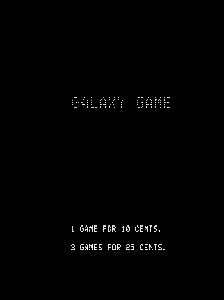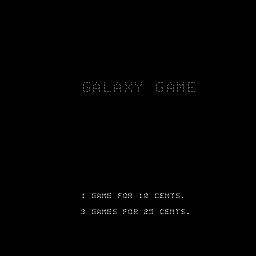 Two recent college graduates in California install a two-player computerized arcade game called Galaxy Game, a modified version of Spacewar! running on a DEC PCP-11 minicomputer, on the Stanford campus, with the machine charging ten cents to play. Whether it is the first coin-operated video game is debated for years, though it can stake the claim of being the earliest computer-controlled coin-op (though the honor of being the first computer-controlled mass-produced arcade game will eventually rest with 1975’s Gun Fight). Galaxy Game remains on the Stanford campus through 1979. (As of the 21st century, it is on display at the Computer History Museum.)
Two recent college graduates in California install a two-player computerized arcade game called Galaxy Game, a modified version of Spacewar! running on a DEC PCP-11 minicomputer, on the Stanford campus, with the machine charging ten cents to play. Whether it is the first coin-operated video game is debated for years, though it can stake the claim of being the earliest computer-controlled coin-op (though the honor of being the first computer-controlled mass-produced arcade game will eventually rest with 1975’s Gun Fight). Galaxy Game remains on the Stanford campus through 1979. (As of the 21st century, it is on display at the Computer History Museum.) ![]()
 The Game: Two ships are locked in deadly deep-space combat, firing interplanetary ordnance at each other. Whoever survives the confrontation is the victor. (1971)
The Game: Two ships are locked in deadly deep-space combat, firing interplanetary ordnance at each other. Whoever survives the confrontation is the victor. (1971)
Memories: Trying to set a starting point for the video game industry sometimes seems like an exercise in trying to nail smoke to the wall. There are plenty of candidates for that starting point, and advocates for each who either have a vested interest in their candidate winning…or at least a vested interest in someone else losing out on the honor. Was it Tennis For Two or was it Spacewar? Pong or the Odyssey? Or… was it these guys from Stanford?
 If you’re not already familiar with the story of Galaxy Game, then “these guys from Stanford” might require a bit of explanation. Bill Pitts, a former Stanford student, had spent his downtime in the school’s computer lab, which, in the late ’60s, meant access to a timeshared DEC PDP-6 computer, back in the day when such computing devices were become small enough to not fill a room. There he met Hugh Tuck, a Cal Poly student using the same computer lab because it was the nearest computer he could access. They often played the early computer game Spacewar! here and began hatching plans to create a self-contained version that anyone could walk up to and play… after putting a coin in the slot.
If you’re not already familiar with the story of Galaxy Game, then “these guys from Stanford” might require a bit of explanation. Bill Pitts, a former Stanford student, had spent his downtime in the school’s computer lab, which, in the late ’60s, meant access to a timeshared DEC PDP-6 computer, back in the day when such computing devices were become small enough to not fill a room. There he met Hugh Tuck, a Cal Poly student using the same computer lab because it was the nearest computer he could access. They often played the early computer game Spacewar! here and began hatching plans to create a self-contained version that anyone could walk up to and play… after putting a coin in the slot.
The birth of coin-operated video games would have to wait until Pitts and Tuck had graduated. In some tellings of the story, they had already seen a prototype of Nolan Bushnell’s Computer Space on campus; in other versions of the story Galaxy Game lands first. Where Computer Space was built around discrete TTL logic, Galaxy Game had a $14,000 DEC PCP-11 controlling its two displays and two sets of controls (the game was strictly a two-player game), though plans were made for expandable installations where pairs of players could face off against each other, all of it controlled by a single computer. Pitts & Tuck set the price at a mere dime. They knew better than to expect it to pay for itself, it was more of a tech demo that would recoup some of its costs while they figured out how to build it at scale.



The “figuring it out” part never quite happened, however, and the coin-operated video game industry took off without them, not because of Computer Space, but because of Pong. In the meantime, the Galaxy Game installation was maintained at Stanford until 1979, when a critical part fizzled, rendering the game unplayable. The dual housings were dismantled and stored, and later reassembled and restored for display (and play) at the Computer History Museum in Mountain View. It can now be emulated in MAME.
Tying to compare an emulated session of Galaxy Game to anything modern is perhaps not fair; the game plods a bit, the display flickers a lot, and normally those would count against a game’s rating in Phosphor Dot Fossils. Perhaps it’s best to recuse Galaxy Game from a rating at all – it’s an odd footnote in video game history, something that may have been far ahead of its time in terms of the technology it was using, and yet far behind the times by today’s standards. Spacewar! had been spreading from college computer lab to college computer lab for a decade, but this was one of the first attempts to turn that into a business. The fact that Galaxy Game and Computer Space – another Spacewar! derivative – arrived right on top of each other – points to it being a viable idea, since there was competition.
A Phosphor Dot Fossil examined by Earl Green
